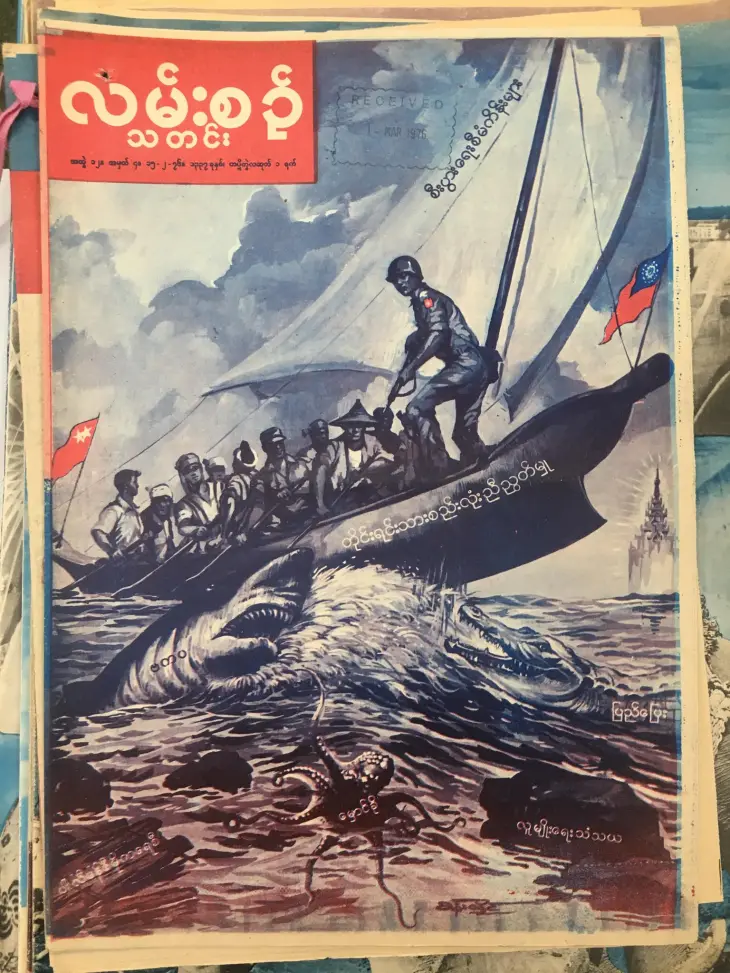Alice Dawkins describes discoveries in the uncatalogued section of the Australian National University’s Menzies Library.
For many ANU students, faculty, and members of the wider Asian Studies community, the Menzies Library is hallowed ground. The library is a dedicated space on campus for Asian studies research, with a spectacular array of collections. Canberra’s dry climate is a perfect condition for housing fragile sources that may struggle to survive in the humidity of their home environments.
In the spirit of openness, many of the library’s resources are available to view directly from the stacks. In a time where our research is increasingly driven by the algorithms of search engines, with content arriving to us in a densely pre-curated manner, a leisurely stroll through the Menzies stacks never fails to bring up surprises. For anyone who has wandered through these aisles, with or without purpose, time spent in Menzies is a rite of passage and cause for nostalgia. In my own research experience, during a search for a particular book I stumbled upon a sixty-year old travel diary, which had nestled untouched for decades in the rolling shelves and in relative obscurity within the academic literature.
Alongside the National Library of Australia, also in Canberra, Menzies plays a critical role as a repository of research on Southeast Asia. In 2017, Menzies hosted an impressive exhibition on the history of ANU’s scholarly work on Burma/Myanmar since independence, in partnership with the Myanmar Research Centre.

It is likely that the Menzies Library has, by measure of period coverage, depth, and diversity of subject, one of the strongest representations of Burmese socialist-era periodicals in a university library. The key titles and the periods covered in the collection include:

Many of these periodicals have been donated by the Myanmar Embassy in Canberra. Lanzin News, a fortnightly periodical, is the most comprehensive series in the holding, offering a broad temporal range and with almost-complete editions for vol. 11 (1975) and well populated for vol. 12 (1976), vol. 19 (1983). The visual component alone is splendid; the full colour front covers and cartoons offer a unique glance into socialist-era aesthetics and the ebbing and flowing of the national imaginary over time. Researchers have an opportunity to combine the outward-facing and visually rich content in Lanzin News and Workers’ Journal with the data-heavy reports from the Party Affairs News Bulletin.
The following group of ethnic affairs texts were not originally published as a series, but I suggest that the texts’ similarities in format, theme, design, era, and political provenance could be harnessed to present them as one. These titles include:

These editions range from the 1970s to the 1980s. Published by either Rangoon University or ethnic literature and culture committees, they have editorials, poetry, short stories, illustrations, and essays. In a country with a rich diversity of ethnic groups, where ethnicity plays a daily role in politics, social life, and indeed what it means to be from Myanmar, this socialist-era view offers a rare window into how ethnic identity was constructed by both locals and outsiders. The ethnic groups represented in these texts include the Zomi, Kayin, Rakhine, Ciimnuai, Chin, Jinghpaw, Kachin, Mon, and Kayah. A cursory search of library catalogues in the US indicates that there was a Shan edition published as well. Some of these texts have content in both Burmese and the local language, while others are only in the local language.
The ethnic affairs magazines bring up fascinating questions: who published them, and why? What were the politics of determining which groups were represented? Who sat on the literature and culture committees, and what were their directives? What vision(s) did they seek to present? The imagery of the front covers certainly give us some sense of the prevailing aesthetic of the era, but questions remain as to their provenance.
Does anyone recognise the ethnic affairs journals listed and pictured above? Do you have any insights into their history and circulation? As these materials enter the library catalogue it would be wonderful to see them digitised. My hope is that these resources can be made available to researchers in and outside of Myanmar to examine these questions, and many others. As political waves across Southeast Asia roll on with various turbulences, there is something quite comforting in the steadfast form of Menzies’ collections and the paper trail it quietly retains of days gone by.
Alice Dawkins has written two honours theses intersecting with Myanmar studies; one on Chinese narratives of the Kuomintang incursion in the Shan states, and one on Myanmar’s young generation of political lawyers. She is a graduate of the Australian National University, where she co-founded a multimedia project about pan-Asia politics and culture.
Like This Article
December 27, 2023
November 07, 2022
September 05, 2022
December 02, 2021
November 25, 2021
March 15, 2021

Center for Southeast Asian Studies, Asian Institute 1 Devonshire Place Toronto, Ontario, M5S 3K7, Canada
©TeaCircle All Rights Reserved 2023